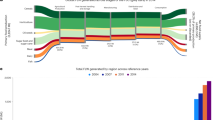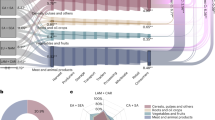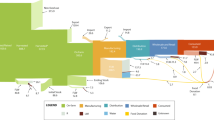Abstract
Food loss and waste (FLW) hampers global food security, human health and environmental sustainability. However, monitoring and benchmarking FLW reduction is often constrained by the lack of reliable and consistent data, especially for emerging economies. Here we use 6 yr large-scale field surveys and literature data to quantify the FLW of major agrifood products along the entire farm-to-fork chain in China. We show that 27% of food annually produced for human consumption in the country (349 ± 4 Mt) is lost or wasted; 45% of this is associated with postharvest handling and storage and 13% with out-of-home consumption activities. We also show that the land, water, carbon, nitrogen and phosphorus footprints associated with total FLW are similar to those of a medium-sized country (such as the United Kingdom’s in the case of carbon footprint). These results highlight the importance of better primary data to inform FLW reduction actions and ensure food security and sustainability.
This is a preview of subscription content, access via your institution
Access options
Access Nature and 54 other Nature Portfolio journals
Get Nature+, our best-value online-access subscription
$29.99 / 30 days
cancel any time
Subscribe to this journal
Receive 12 digital issues and online access to articles
$119.00 per year
only $9.92 per issue
Buy this article
- Purchase on Springer Link
- Instant access to full article PDF
Prices may be subject to local taxes which are calculated during checkout





Similar content being viewed by others
Data availability
The data that support the findings of this study are available in the Supplementary Information. Source data are provided with this paper.
Code availability
The codes for data processing are conducted in Microsoft Excel 2016 and Matlab (R2020a), and data illustration is generated in Origin 2016 and Microsoft Visio 2010.
References
Foley, J. A. et al. Solutions for a cultivated planet. Nature 478, 337–342 (2011).
Tilman, D. & Clark, M. Global diets link environmental sustainability and human health. Nature 515, 518–522 (2014).
Behrens, P. et al. Evaluating the environmental impacts of dietary recommendations. Proc. Natl Acad. Sci. USA 114, 13412–13417 (2017).
Springmann, M. et al. Options for keeping the food system within environmental limits. Nature 562, 519–525 (2018).
Poore, J. & Nemecek, T. Reducing food’s environmental impacts through producers and consumers. Science 360, 987–992 (2018).
Gustavsson, J., Cederberg, C., Sonesson, U., Otterdijk, R. van & Meybeck, A. Global Food Losses and Food Waste: Extent, Causes and Prevention (FAO, 2011); http://www.fao.org/docrep/014/mb060e/mb060e00.pdf
Sustainable Development Goals 2030 (UN, 2015); https://sustainabledevelopment.un.org
Circular Economy Action Plan: For a Cleaner and More Competitive Europe (European Commission, 2020).
A Farm to Fork Strategy for a Fair, Healthy and Environmentally-friendly Food System (European Commission, 2020).
Gil, J. Going to waste. Nat. Food 1, 192 (2020).
Xue, L. et al. Missing food, missing data? A critical review of global food losses and food waste data. Environ. Sci. Technol. 51, 6618–6633 (2017).
Parfitt, J., Barthel, M. & Macnaughton, S. Food waste within food supply chains: quantification and potential for change to 2050. Philos. Trans. R. Soc. B Biol. Sci. 365, 3065–3081 (2010).
Dorward, L. J. Where are the best opportunities for reducing greenhouse gas emissions in the food system (including the food chain)? A comment. Food Policy 37, 463–466 (2012).
Chaudhary, A., Gustafson, D. & Mathys, A. Multi-indicator sustainability assessment of global food systems. Nat. Commun. 9, 848 (2018).
Lopez Barrera, E. & Hertel, T. Global food waste across the income spectrum: Implications for food prices, production and resource use. Food Policy 98, 101874 (2020).
Liu, G., Liu, X. & Cheng, S. Curb China’s rising food wastage. Nature 498, 170 (2013).
Liu, G. Food Losses and Food Waste in China: A First Estimate. OECD Food, Agriculture and Fisheries Papers No. 66 (OECD, 2014); https://doi.org/10.1787/5jz5sq5173lq-en
Liu, J., Lundqvist, J., Weinberg, J. & Gustafsson, J. Food losses and waste in China and their implication for water and land. Environ. Sci. Technol. 47, 10137–10144 (2013).
Chen, X. et al. Producing more grain with lower environmental costs. Nature 514, 486–489 (2014).
Zhang, W. F. et al. New technologies reduce greenhouse gas emissions from nitrogenous fertilizer in China. Proc. Natl. Acad. Sci. USA 110, 8375–8380 (2013).
Larson, C. Losing arable land, China faces stark choice: adapt or go hungry. Science (80-.). 339, 644–645 (2013).
Ghisellini, P., Setti, M. & Ulgiati, S. Energy and land use in worldwide agriculture: an application of life cycle energy and cluster analysis. Environ. Dev. Sustain. 18, 799–837 (2016).
Zhang, H., Duan, H., Andric, J. M., Song, M. & Yang, B. Characterization of household food waste and strategies for its reduction: a Shenzhen City case study. Waste Manag. 78, 426–433 (2018).
Wang, L.-E. et al. The weight of unfinished plate: a survey based characterization of restaurant food waste in Chinese cities. Waste Manag. 66, 3–12 (2017).
Wu, Y., Tian, X., Li, X., Yuan, H. & Liu, G. Characteristics, influencing factors, and environmental effects of plate waste at university canteens in Beijing, China. Resour. Conserv. Recycl. 149, 151–159 (2019).
FAO. The State of Food and Agriculture 2019. Moving Forward on Food Loss and Waste Reduction (FAO, 2019); https://doi.org/10.1002/9780470172506.ch60
How to Cut Food Waste and Maintain Food Safety (US FDA, 2019).
Bräutigam, K.-R., Jörissen, J. & Priefer, C. The extent of food waste generation across EU-27: different calculation methods and the reliability of their results. Waste Manag. Res. 32, 683–694 (2014).
Liu, C. et al. Food waste in Japan: trends, current practices and key challenges. J. Clean. Prod. 133, 557–564 (2016).
Food Surplus and Waste in the UK—Key Facts (WRAP, 2020); https://wrap.org.uk/sites/files/wrap/Food_surplus_and_waste_in_the_UK_key_facts_Jan_2020.pdf
Monier, V. et al. Preparatory Study on Food Waste Across EU27 (European Communities, 2010); http://ec.europa.eu/environment/eussd/pdf/bio_foodwaste_report.pdf
Nahman, A. & de Lange, W. Costs of food waste along the value chain: evidence from South Africa. Waste Manag. 33, 2493–2500 (2013).
Food Waste and the Circular Economy of the Food System (in Finnish) (Natural Resources Institute Finland, 2016).
Lemaire, A. & Limbourg, S. How can food loss and waste management achieve sustainable development goals? J. Clean. Prod. 234, 1221–1234 (2019).
Song, G., Li, M., Semakula, H. M. & Zhang, S. Food consumption and waste and the embedded carbon, water and ecological footprints of households in China. Sci. Total Environ. 529, 191–197 (2015).
Sun, S. K. et al. Impacts of food wastage on water resources and environment in China. J. Clean. Prod. 185, 732–739 (2018).
Li, B. et al. Food waste and the embedded phosphorus footprint in China. J. Clean. Prod. 252, 119909 (2020).
Gu, B. et al. Characterization, quantification and management of China’s municipal solid waste in spatiotemporal distributions: a review. Waste Manag. 61, 67–77 (2017).
Wen, Z., Wang, Y. & De Clercq, D. What is the true value of food waste? A case study of technology integration in urban food waste treatment in Suzhou City, China. J. Clean. Prod. 118, 88–96 (2016).
Hoekstra, A. Y. & Chapagain, A. K. Water footprints of nations: water use by people as a function of their consumption pattern. Water Resour. Manag. 21, 35–48 (2007).
Mekonnen, M. M. & Hoekstra, A. Y. The Green, Blue and Grey Water Footprint of Production and Consumption. Vol. 2: Appendices. Value of Water Research Report Series No. 50 (UNESCO-IHE Institute for Water Education, 2011); https://ris.utwente.nl/ws/portalfiles/portal/5146139/Report50-NationalWaterFootprints-Vol2.pdf.pdf
Zhang, H. et al. Anaerobic digestion based waste-to-energy technologies can halve the climate impact of China’s fast-growing food waste by 2040. J. Clean. Prod. 2777, 123490 (2020).
Ritchie, H. & Max Roser, M. CO2 and Greenhouse Gas Emissions (Our World In Data, 2017); https://ourworldindata.org/co2-and-other-greenhouse-gas-emissions
Hammond, R. A. & Dubé, L. A systems science perspective and transdisciplinary models for food and nutrition security. Proc. Natl. Acad. Sci. USA 109, 12356–12363 (2012).
Dou, Z. et al. Assessing US food wastage and opportunities for reduction. Glob. Food Sec. 8, 19–26 (2016).
Willett, W. et al. Food in the Anthropocene: the EAT–Lancet Commission on healthy diets from sustainable food systems. Lancet 393, 447–492 (2019).
Read, Q. D. et al. Assessing the environmental impacts of halving food loss and waste along the food supply chain. Sci. Total Environ. 712, 136255 (2020).
Damerau, K., Waha, K. & Herrero, M. The impact of nutrient-rich food choices on agricultural water-use efficiency. Nat. Sustain 2, 233–241 (2019).
Shafiee-Jood, M. & Cai, X. Reducing food loss and waste to enhance food security and environmental sustainability. Environ. Sci. Technol. 50, 8432–8443 (2016).
Piesse, M. The Wasteful Dragon: Food Loss and Waste in China (Future Directions International, 2017); http://www.futuredirections.org.au/publication/wasteful-dragon-food-loss-waste-china/
Food Balance Database (FAO, 2013); http://www.fao.org/faostat/en/#data/FBSH
Zhou, Y. et al. Sharing tableware reduces waste generation, emissions and water consumption in China’s takeaway packaging waste dilemma. Nat. Food 1, 552–561 (2020).
Zhang, P., Zhang, D. & Cheng, S. The effect of consumer perception on food waste behavior of urban households in China. Sustainability 12, 5676 (2020).
Yang, Y., Bao, W. & Xie, G. H. Estimate of restaurant food waste and its biogas production potential in China. J. Clean. Prod. 211, 309–320 (2019).
Emissions—Agriculture Database (FAO, 2017); http://www.fao.org/faostat/en/#data/GT
Mekonnen, M. M. & Hoekstra, A. Y. The Green, Blue and Grey Water Footprint of Farm Animals and Animal Products. Vol. 2: Appendices. Value of Water Research Report Series No. 48 (UNESCO-IHE Institute for Water Education, 2010); https://ris.utwente.nl/ws/portalfiles/portal/5146069/Report-48-WaterFootprint-AnimalProducts-Vol2.pdf
Mekonnen, M. M. & Hoekstra, A. Y. The Green, Blue and Grey Water Footprint of Crops and Derived Crop Products. Vol. 2: Appendices. Value of Water Research Report Series No. 47 (UNESCO-IHE Institute for Water Education, 2010); https://ris.utwente.nl/ws/portalfiles/portal/59480760/Report47_WaterFootprintCrops_Vol2.pdf
Jianyi, L., Yuanchao, H., Shenghui, C., Jiefeng, K. & Lilai, X. Carbon footprints of food production in China (1979–2009). J. Clean. Prod. 90, 97–103 (2015).
Cui, S., Shi, Y., Groffman, P. M., Schlesinger, W. H. & Zhu, Y.-G. Centennial-scale analysis of the creation and fate of reactive nitrogen in China (1910–2010). Proc. Natl Acad. Sci. USA 110, 2052–2057 (2013).
Gu, B., Ju, X., Chang, J., Ge, Y. & Vitousek, P. M. Integrated reactive nitrogen budgets and future trends in China. Proc. Natl Acad. Sci. USA 112, 8792–8797 (2015).
Liu, X. et al. Intensification of phosphorus cycling in China since the 1600s. Proc. Natl Acad. Sci. USA 113, 2609–2614 (2016).
Cui, S. et al. Changing urban phosphorus metabolism: evidence from Longyan City, China. Sci. Total Environ. 536, 924–932 (2015).
Acknowledgements
This work is based upon extensive FLW data collected between 2013 and 2019 by nearly 50 researchers, all of whom we thank for their hard work and dedication. We especially acknowledge (alphabetically) Junfei Bai, Xiaochang Cao, Xiaopeng Chen, Liwei Gao, Peng Hou, Jiazhang Huang, Tai Li, Yunyun Li, Jun Liu, Litao Liu, Yao Liu, Fei Lun, Qi Qin, Lingen Wang, Yu Wang, Liang Wu, Wenbin Wu, Shiwei Xu, Wen Yu, Jinling Zhao, Dan Zhang and Panpan Zhang for invaluable collaboration and the hundreds of student assistants in the field surveys. This work has also benefited from the discussion with Morvarid Bagherzadeh from the Trade and Agriculture Directorate, Organisation for Economic Co-operation and Development and with Concepcion Calpe from the FAO. Sponsors have included the Strategic Priority Research Programme of the Chinese Academy of Sciences (XDA26050200), the National Natural Science Foundation of China (71233007), the Horizon 2020 Framework Programme of the European Union (REFRESH, 641933), the National Key Research and Development Plan of China (2016YFE0113100), the China National Postdoctoral Program for Innovative Talents (BX20190326), Oxfam, and WWF (World Wide Fund for Nature).
Author information
Authors and Affiliations
Contributions
G.L. and S.C. conceived, designed and led the work. X.L. and L.X. coordinated the field study and data collection on consumer food waste. S.L. and G.C. coordinated the field study and data collection on supply chain food losses. Y.H. and J.L. contributed to footprint data collection and analysis. Z.D. enhanced the international comparison and discussion. L.X. and G.L. drafted the paper and drew the figures. All authors contributed to discussing the results and writing the paper.
Corresponding author
Ethics declarations
Competing interests
The authors declare no competing interests.
Additional information
Peer review information Nature Food thanks Dabo Guan and the other, anonymous, reviewer(s) for their contribution to the peer review of this work.
Publisher’s note Springer Nature remains neutral with regard to jurisdictional claims in published maps and institutional affiliations.
Supplementary information
Supplementary Information
Supplementary methods, results, Figs. 1–15, Tables 1–39 and references.
Source data
Source Data Fig. 1
Source data from the model results to generate Fig. 1.
Source Data Fig. 2
Source data from the model results to generate Fig. 2.
Source Data Fig. 3
Source data from the model results to generate Fig. 3.
Source Data Fig. 4
Source data from the model results to generate Fig. 4.
Source Data Fig. 5
Source data from the model results to generate Fig. 5.
Rights and permissions
About this article
Cite this article
Xue, L., Liu, X., Lu, S. et al. China’s food loss and waste embodies increasing environmental impacts. Nat Food 2, 519–528 (2021). https://doi.org/10.1038/s43016-021-00317-6
Received:
Accepted:
Published:
Issue Date:
DOI: https://doi.org/10.1038/s43016-021-00317-6
This article is cited by
-
Quantitative food loss in the global supply chain
Nature Food (2024)
-
Decreasing resilience of China’s coupled nitrogen–phosphorus cycling network requires urgent action
Nature Food (2024)
-
Health burden from food systems is highly unequal across income groups
Nature Food (2024)
-
A Hybrid Framework for Selecting Food Waste Treatment Techniques Using q-Rung Orthopair Fuzzy CRITIC-Generalized TODIM Method
International Journal of Fuzzy Systems (2024)
-
Research progress in assessment and strategies for sustainable food system within planetary boundaries
Science China Earth Sciences (2024)



